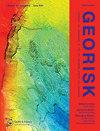Evaluating Post-Fire Erosion and Flood Protection Techniques: A Narrative Review of Applications
IF 4.8
3区 工程技术
Q1 ENGINEERING, GEOLOGICAL
Georisk-Assessment and Management of Risk for Engineered Systems and Geohazards
Pub Date : 2023-10-10
DOI:10.3390/geohazards4040022
引用次数: 0
Abstract
Wildfires affect and change the burned sites’ condition, functionality, and ecosystem services. Altered hydrologic processes, such as runoff, increased streamflows, and sediment transport, are only a few examples resulting from burned soils, vegetation, and land cover. Such areas are flood-prone and face risks of extreme peak flows, reduced infiltration, water pollution affecting habitats, and hydromorphological changes. In this study, we present the different post-fire erosion and flood protection treatments that have been developed to avoid and mitigate the consequences and risks mentioned above. We categorize them into Land, Channel, Barrier, and Road treatments and analyze their types, such as cover-based methods, barriers, mulching, in-channel treatments, such as check dams, seeding, or even chemical treatments. Examples of how such treatments were used in real cases are provided, commenting on their results in flood and erosion protection. We found that cover changes were more effective than barriers, as they provided an immediate ground-cover increase in both Mediterranean and US sites. We explore the factors that play a role in their effectiveness, including storm duration and intensity, topography and slopes, land cover and uses, treatment implementation-installation, as well as fire-related factors such as burn severity. These factors have different effects on different treatments, so we further discuss the suitability of each one depending on the site’s and treatment’s characteristics. The outcomes of this work are expected to improve the understanding of the practical aspects of these treatments, providing for the first time a synthesis of the available knowledge on the multiple complex factors that can determine their efficiency.评估火灾后侵蚀和防洪技术:应用的叙述性回顾
野火影响和改变了被烧毁地点的状况、功能和生态系统服务。由于土壤、植被和土地覆盖的燃烧,水文过程的改变,如径流、河流流量的增加和沉积物的运输,只是其中的几个例子。这些地区容易发生洪水,面临着极端峰值流量、入渗减少、影响栖息地的水污染和水文形态变化的风险。在本研究中,我们提出了不同的火灾后侵蚀和防洪处理方法,以避免和减轻上述后果和风险。我们将它们分为陆地、通道、屏障和道路处理,并分析了它们的类型,如覆盖方法、屏障、覆盖、通道内处理,如拦坝、播种,甚至化学处理。文中提供了这些处理方法在实际应用中的实例,并对其在防洪和防侵蚀方面的效果进行了评价。我们发现覆盖范围的变化比屏障更有效,因为它们在地中海和美国都能立即增加地面覆盖范围。我们探讨了影响其有效性的因素,包括风暴持续时间和强度、地形和坡度、土地覆盖和使用、处理实施-安装,以及与火灾相关的因素,如烧伤严重程度。这些因素对不同的处理有不同的影响,因此我们根据场地和处理的特点进一步讨论每个因素的适用性。这项工作的结果有望提高对这些治疗的实际方面的理解,首次提供了对决定其有效性的多种复杂因素的现有知识的综合。
本文章由计算机程序翻译,如有差异,请以英文原文为准。
求助全文
约1分钟内获得全文
求助全文
来源期刊
CiteScore
8.70
自引率
10.40%
发文量
31
期刊介绍:
Georisk covers many diversified but interlinked areas of active research and practice, such as geohazards (earthquakes, landslides, avalanches, rockfalls, tsunamis, etc.), safety of engineered systems (dams, buildings, offshore structures, lifelines, etc.), environmental risk, seismic risk, reliability-based design and code calibration, geostatistics, decision analyses, structural reliability, maintenance and life cycle performance, risk and vulnerability, hazard mapping, loss assessment (economic, social, environmental, etc.), GIS databases, remote sensing, and many other related disciplines. The underlying theme is that uncertainties associated with geomaterials (soils, rocks), geologic processes, and possible subsequent treatments, are usually large and complex and these uncertainties play an indispensable role in the risk assessment and management of engineered and natural systems. Significant theoretical and practical challenges remain on quantifying these uncertainties and developing defensible risk management methodologies that are acceptable to decision makers and stakeholders. Many opportunities to leverage on the rapid advancement in Bayesian analysis, machine learning, artificial intelligence, and other data-driven methods also exist, which can greatly enhance our decision-making abilities. The basic goal of this international peer-reviewed journal is to provide a multi-disciplinary scientific forum for cross fertilization of ideas between interested parties working on various aspects of georisk to advance the state-of-the-art and the state-of-the-practice.

 求助内容:
求助内容: 应助结果提醒方式:
应助结果提醒方式:


